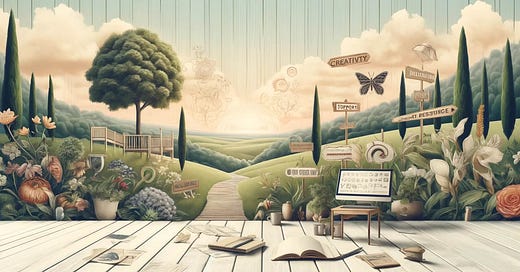After a mentally challenging and intense week, it’s important not to lose heart that your creative muse will be impossible to find when you can finally sit down and write.
Although exhausted, I know it will come when I need it—like writing this week’s newsletter. I’ve told myself for a while that inspiration can be found everywhere and in everything. But I never really believed it; this article proves I was right all along.
I’ve been writing extensively all week, but unfortunately, none was creative. I’ve mostly been raising and reacting to software support tickets. It’s been a testing week, literally, testing a new software application release for my largest client.
My AI assistant suggests outlines, topics, or subtleties I hadn’t considered. The actual writing is all human me. The assistant also advises me when I’m boring, if I listen.
Follow me here to see more articles, posts, and discussions about Business and Creativity. The Everyday Solopreneur newsletter is a reader-supported publication. To receive new posts and support my work, consider becoming a free or paid subscriber. I would appreciate the support.
As I write this, I’m sitting on my garden terrace enjoying the sunshine. Relaxed after the daily chores. What could be more conducive to a bit of creativity?
Let us dive into the creative process and how to find the inspiration that drives it.
Making Waves with Mindful Observation.
If you can keep an open and curious mind, you will always find something to write about. It may not be suitable for a blog post, perhaps only a note to journal about at day’s end, but that isn’t the point.
Training yourself to be observant and proactive is the key. Noticing the smallest details and remaining curious will always provide something to write about.
For example, the subject of this post was an observation of my own state of mind after a difficult week—something that was the seed of an idea. One quickly dictated note contained no more than a poorly worded sentence or two. Rereading the note this morning got me thinking.
So, it needn’t be a deep and well-researched piece; a tiny germ of an idea is enough for a creative to pick up and run with. It inevitably leads to follow-up thoughts and introspection.
What it does achieve is the building of confidence. No matter how tired your mind is or how physically exhausted you may be, you, as a creative, have to trust that ideas will never cease to flow.
Creativity is proactive, but why are so many obsessed with passive consumption?
Consumer Culture and Creative Blindness
It sounds so simple, but everybody would do it if it were that easy. We must understand why it’s so difficult for us, ordinary mortals, to be observant.
Modern society is a consumer society, but it wasn’t always like this. Consumerism is a necessary requirement for capitalism. Without consumers, capitalism has nowhere to go and would very quickly wither and die.
The shift began directly after the end of World War II, shifting toward what we recognize today as a consumer-oriented culture. It was mainly driven by technological advances, a direct consequence of the war, which, in turn, fueled rapid economic growth.
Developments in marketing helped to ensure the continuation of this growth, and as a consequence, advertising and promises of a better future for all required that society be less inquisitive and content with passive consumption.
There are several key factors and historical developments that contributed to this shift:
After World War II, the “golden age of capitalism” saw rising wages, low unemployment, and an increased standard of living.
Technological innovations, many of which were developed during the war, allowed for the mass production of goods at lower costs
The rise of television played a role; advertising became more sophisticated and widespread, promoting a culture of consumption.
Services such as credit cards and payment plans became widespread, enabling consumers to buy now and pay later.
In the early 20th century, consumption was limited to necessities rather than luxury purchases, and the post-war years marked a shift in Western societies’ values towards a consumer-oriented culture.
It is easier for people in a developed society to be content to sit back and absorb content rather than be the originators of said content. It may be argued that this trend has gone so far over the last sixty to seventy years that the average Joe or Jane can no longer sustain original thought.
To be creative marks a person out as an exception to the rule. We consume; how could we not? We also question. We are a curious bunch.
Best we redefine creativity in the context of one’s life experiences.
Creativity: A Universal Trait
There is no hard and fast rule dictating why one person is creative among the hundreds, perhaps thousands, who are not. It depends on how we define whatever a creative is.
Creativity manifests itself in many seemingly unrelated ways. Think of a software developer, a landscape gardener, a medical doctor, or an accomplished chef. Each is creative and has their field of expertise. They may also be committed consumers, passively absorbing books and streaming series on Netflix or Prime.
Perhaps we should narrow down the focus of our search for creatives and their definitions. Let us talk about the creative writer or author instead of the unreliable generalization of the descriptor ‘creative.’
A creative writer is an artist in a way that sets them apart from the more general creative. After all, humanity’s natural state is to be creative and curious.
So, what makes a creative writer?
Following the Muse
I can only speak for myself, obviously. I wouldn’t even be so presumptuous to call myself a creative writer. That may only be judged by others.
I’ve noticed several idiosyncrasies about the way my mind works that, in my opinion, at least define my specific form of creativity.
The creative process starts with simple, everyday things. Creative writers often have a distinct way of observing the world, enabling them to find inspiration in the everyday and the extraordinary.
The thought processes can be described in several key aspects:
Creative writers tend to be exceptionally observant, noticing small details and subtleties in behavior that others might overlook.
Writers are typically driven by curiosity. They ask questions about what happens, why it happens, and what it means.
Creative writers consistently connect unrelated ideas to form new, innovative concepts.
Writing often requires deep introspection, not only about the subject matter but also about personal beliefs and feelings.
This reflective process helps writers understand their perspectives and biases.
Creative writers draw inspiration from their environments and the cultures they are part of or observe.
This is the long and the short of it. Sounds simple.
Final Thoughts
I started this newsletter on ideas and origins of inspiration, pivoting to a brief discussion of consumerism and capitalism and ending up trying to define what it is to be a creative writer.
I think we can say that the flow of this article illustrates very well what creative writing is all about. While the quality of my words may not be that high, perhaps poorly written, the ideas that flow from one to the other have a deeper meaning.
Creative writers follow and transcribe their thoughts into a form to be shared with other, hopefully like-minded souls. Or those who wish to escape from reality, even for a few minutes.
I don’t have many comments for my posts; perhaps the quality is too poor to merit that much attention. However, I would sincerely love to hear from other creatives.
It can be quite lonely. So please comment; I will answer every comment; it would make this more of a conversation.
Hopefully, you enjoyed this post. If you want to say ‘thank you, ‘ the best way is to get involved in the comments. And my promise to you…If you get in touch, I will answer! So comment away… (a subscription is also nice)






